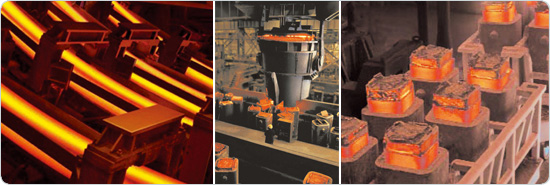Technical>Cage material

Cage material
Material for cages is required to have properties of good wear resistance, dimensional stability and good mechanical strength for perfect bearing running purpose. Therefore, for selection of cage material, it is important to consider the operation conditions.
● Sheet steel cages
These light weight cages have relatively high strength and can be surface treated to further reduce friction and wear. Cold-rolled steel is used for pressed cages.(Specification see the below table)
● Sheet brass cages
Pressed sheet brass cages are used for some small and medium-sized bearings. In applications such as compressors for refriger-action using ammonia, season cracking in sheet brass might occur, therefore steel cages should be used instead.
● Polymer cages
Polyamide resin is applied depending on the type of bearing and the application, but should not be used at temperatures above 120 ℃ or below -40℃. For the majority of injection moulded cages, polyamide 6.6 is used. This material, with glass fibre reinforcement or without, is characterized by a favourable combination of strength and elasticity.
 The mechanical properties like strength and elasticity of polymeric materials are temperature dependent and subject to permanent changes under operating conditions, called ageing. The most important factors that play a role in this ageing behaviour are temperature, time and the medium (lubricant) to which the polymer below. The relationship between these factors for glass fibre reinforced polyamide 6.6 is illustrated in diagram. It appears that the cage life decreases with increasing temperature and the aggressiveness of the lubricant.Therefore, whether polyamide cages are suitable for a specific application depends on the operating conditions and life requirements.
The mechanical properties like strength and elasticity of polymeric materials are temperature dependent and subject to permanent changes under operating conditions, called ageing. The most important factors that play a role in this ageing behaviour are temperature, time and the medium (lubricant) to which the polymer below. The relationship between these factors for glass fibre reinforced polyamide 6.6 is illustrated in diagram. It appears that the cage life decreases with increasing temperature and the aggressiveness of the lubricant.Therefore, whether polyamide cages are suitable for a specific application depends on the operating conditions and life requirements.
Notes: Please consult the HCH application engineering service for cage availability for specific bearing executions.
● Sheet steel cages
These light weight cages have relatively high strength and can be surface treated to further reduce friction and wear. Cold-rolled steel is used for pressed cages.(Specification see the below table)
| Sheet Steel No. | Chemical Composition % | ||||||
| JISG 3141 SPCC | C | Si | Mn | P | S | Ni | Cr |
| < 0.12 | < 0.5 | < 0.04 | < 0.045 | ||||
● Sheet brass cages
Pressed sheet brass cages are used for some small and medium-sized bearings. In applications such as compressors for refriger-action using ammonia, season cracking in sheet brass might occur, therefore steel cages should be used instead.
| Standard | Symbols | Chemical Composition % | ||||||||
| Cu | Zn | Mn | Fe | Al | Sn | Ni | Impurities | |||
| Pb | Si | |||||||||
| JIS H 5120 | CAC301 (HBsC 1) | 55.0 - 60.0 | 33.0 - 42.0 | 0.1 - 1.5 | 0.5 - 1.5 | 0.5 -1.5 | < 1.0 | < 1.0 | < 0.4 | < 1.0 |
| JIS H 3250 | C 6782 | 56.0 - 60.5 | Residual | 0.1 - 1.5 | 0.5 -1.5 | 0.5 -1.5 | - | - | < 0.5 | - |
● Polymer cages
Polyamide resin is applied depending on the type of bearing and the application, but should not be used at temperatures above 120 ℃ or below -40℃. For the majority of injection moulded cages, polyamide 6.6 is used. This material, with glass fibre reinforcement or without, is characterized by a favourable combination of strength and elasticity.
 The mechanical properties like strength and elasticity of polymeric materials are temperature dependent and subject to permanent changes under operating conditions, called ageing. The most important factors that play a role in this ageing behaviour are temperature, time and the medium (lubricant) to which the polymer below. The relationship between these factors for glass fibre reinforced polyamide 6.6 is illustrated in diagram. It appears that the cage life decreases with increasing temperature and the aggressiveness of the lubricant.Therefore, whether polyamide cages are suitable for a specific application depends on the operating conditions and life requirements.
The mechanical properties like strength and elasticity of polymeric materials are temperature dependent and subject to permanent changes under operating conditions, called ageing. The most important factors that play a role in this ageing behaviour are temperature, time and the medium (lubricant) to which the polymer below. The relationship between these factors for glass fibre reinforced polyamide 6.6 is illustrated in diagram. It appears that the cage life decreases with increasing temperature and the aggressiveness of the lubricant.Therefore, whether polyamide cages are suitable for a specific application depends on the operating conditions and life requirements.Notes: Please consult the HCH application engineering service for cage availability for specific bearing executions.




